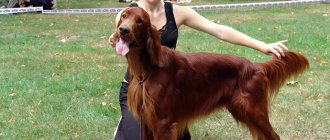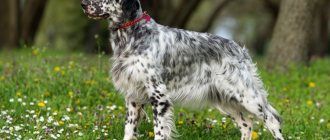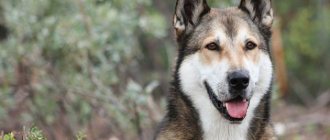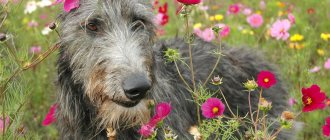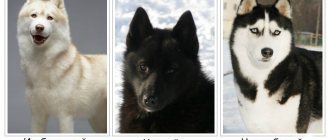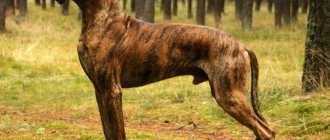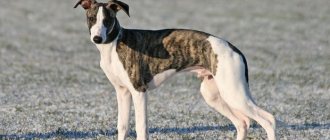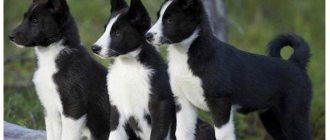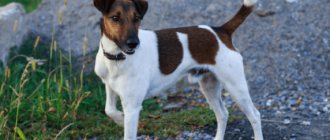Main characteristics
| Breed parameters | |
| Country of origin: | Great Britain |
| Weight of the breed: | males: 25-36 kg, females: 20-32 kg |
| Height at withers: | males: 61-69 cm, females: 58-66 cm |
| Temperament: | active |
| Wool: | average |
| Role in human life: | companion, hunting |
Despite the large number of advantages, the breed has not become fashionable. This happened due to the Scottish Setter’s great mobility and unsuitability for small spaces. The dog will not be able to get along in an apartment unless it has a significant square footage. It is much more familiar and easier for a hunter to scour the area of a private house. Temperament will not allow the setter to become a simple pet.
Description
An interesting breed of dog, the Scottish Setter is similar to the more popular English and Irish Setters, but is slightly larger and has a black and tan color. These animals are quite large: on average, a male at the withers reaches 68 centimeters with a weight of 34 kilograms, a female – up to 61 centimeters with a weight of 26 kilograms.
These dogs are the largest breed of setters in existence. They are very muscular and have strong bones. The tail is quite short, thick near the base, and pointed at the end.
The muzzle of the representatives of the breed is elegant, one might even say refined. The head is located on a thin, but at the same time long neck, which is why it may seem that the animal is smaller than it really is. The head is quite small, the muzzle is long.
The long muzzle gives these dogs a significant advantage, because it accommodates many olfactory receptors. The animals have large eyes and a smart facial expression. The ears are quite long, drooping, and triangular in shape. They are covered abundantly with fur, which is why they look larger than they actually are.
A distinctive characteristic of the breed is its fur. Like other setters, it is of medium length, but does not limit the movement of the animal. The fur is smooth, slightly wavy, but not curly.
The fur is the same length along the body, and only on the paws and muzzle is it short. Long fur covers the ears, tail, and back of the limbs, where feathering is formed. On the tail it is longer at the base and much shorter at the tip.
The main characteristic that the Scottish Setter has, and whose breed description indicates this, is the presence of a black and tan color. Black should be as dark as possible, without any hints of rust. The difference between colors must be clearly visible; a smooth transition is not allowed.
History of the breed
Initially, the black and tan setter was bred in Great Britain (Scotland, England) for hunting partridges. Catching small animals and birds is of particular importance to the island's inhabitants. Previously, the Scotch Terrier (Scottish Terrier) was widely known, specializing in catching foxes and badgers. The typical description of the Scottish Terrier breed is that it is small but robust and has a wheaten or brindle coat. And yet the dog is unremarkable due to his height.
For hunting, a much more powerful and stubborn breed was required. The hunters understood that tracking down birds would require considerable strength from the dog. The setter had to run and catch prey in marshy areas, mountain hills and hills. It is not difficult to guess that such tricks will require strong limbs and endurance.
The development of the breed was carried out by hunters of medium and small incomes; only later the pets became famous among other segments of the population. Duke A. Gordon played a huge role in breeding, who noticed this favorite and its unusual qualities. The Duke subsequently introduced an improved version of the Scottish dog. The ancestor of the breed is considered to be black and black and tan pointers.
The development work did not end there. Mixings were carried out with Irish setters, spaniels, bloodhounds, and pointers. Outwardly, today's Gordon is most similar to his Irish counterpart. The considerable period from the first appearance to the approval of the breed standard and the description of its exact characteristics indicates long breeding work.
The history of the appearance of the Scottish Setter began in the 18th century, but the breed standard was described only in 1988. The new aristocratic dog gradually gained popularity in other countries of the world.
There is a known case of a Scottish setter named Lassie, together with his owner, participating in rescue operations following an earthquake in Neftegorsk. After that, the bitch helped dog handlers in catching terrorists, saving people's lives. This once again proves that the Gordon Setter is a loyal and reliable friend who will not leave you in trouble.
Lassie is not the only dog known for her exploits. Such actions are characteristic of every Scottish Gordon.
Origin story
This distinctive breed of gundog gundogs was obtained experimentally in the middle of the 18th century. Thanks to his passion for hunting, a Scottish nobleman from the Gordon family tried, and, as it later turned out, quite successfully, to get his own setter - strong, powerful, hardy, with a particularly developed instinct.
Working on working qualities, he started breeding some representatives of the setter group, infusing the blood of Spanish marriages and water spaniels, but exclusively black and tan. Duke Alexander Gordon received such a cop, which was appreciated during his lifetime.
Subsequently, the breed was only improved. But crossing the Scotch Setter with the Collie was unsuccessful. By mixing in the Blackhound, the breed was restored and fully formed already in 1860, gaining widespread popularity throughout the world. In 1891, the first description of the dogs appeared, and in 1939 the Scottish Gordon Setter standard was adopted, which is still in effect today.
Care and maintenance
The low popularity of the Scottish Setter is also explained by the fact that he does not know how to spend his days idle. The dog needs “physical education” - walks, training, running. The best option for a black Gordon is to combine walking with training, and the procedure can take an hour or more. Not every person is ready to play sports with their pet.
Among all the setters, the Scottish one will be the most difficult for a beginner to breed or train.
For the Scottish Gordon, it is optimal if he is given a large territory. Therefore, it is advisable to get a dog if you have a private home or the opportunity to visit it often. The ideal option is country life, the presence of a summer cottage. At the same time, the Scottish Setter requires supervision: it can easily jump over a small fence and dig under a hole. You should not let your pet out alone.
Content Features
The Scottish Setter is not poorly suited to living in an apartment, but only if it receives the necessary level of physical activity, which is especially important to provide to a growing puppy. Scots are not short-haired dogs, so it is possible to keep them in an open enclosure with an insulated booth. The difficulty in this case is that Gordon needs close contact with the owner; if this is lacking, difficulties arise in mutual understanding and work. It is not advisable to keep a dog outside that will participate in exhibitions. The structure of her coat changes and a powerful undercoat is formed, which changes her appearance not for the better.
Physical activity should be regular and active, regardless of where the dog lives, in an apartment or in the yard of a private house.
At least once a week you need to go out of town and let the animal “let off steam.” Very useful for Gordon are jogging or cycling for a duration of 3 to 10 km, which can be started from 9 months, gradually increasing the load. It is important to ensure that the setter moves at a trot and does not break into a gallop.
Care
An unkempt Scottish Setter is a very pitiful sight. Of course, a dog for exhibitions needs more complex and regular care than a working Scotsman, as they say, for the soul.
The dog is quite woolly, so burdock, grass seeds, branches, etc. constantly stick to it; they need to be removed with a wide-toothed comb. To maintain a neat appearance and prevent the formation of tangles, it is advisable to check and comb the coat every two to three days, and if the hair is very thick and the dog walks a lot in the meadow or field, then daily. It is advisable to bathe Gordon once a month. Use suitable shampoo and conditioner. Show dogs are washed every 7-10 days. After bathing, it is advisable to use a thermoactive balm, which neutralizes the harmful effects of hot air on the wool when drying with a hairdryer. In addition, cream, oil or masks are applied to the entire length of the hair, moisturizing the skin and nourishing the hair. During walks, I protect the ears of show dogs with so-called headphones, which cocker players are very fond of.
At shows, the Scottish Setter is shown in its most natural appearance, but a light haircut is necessary. Trim the hair on the fringes, in the anus area and between the toes. Working dogs often have their hair completely trimmed before the hunting season; this makes caring for them much easier.
And of course, ears and teeth need regular care, which are cleaned at least once a week. The eyes are rubbed as needed, removing the secretions accumulated in the corners. Claws are trimmed as they grow, approximately once every 3-4 weeks. A dog with long nails gets tired faster and increases the risk of injury.
Nutrition
The owner himself decides how to provide the dog with complete, balanced nutrition, whether it be natural food or dry industrial food. When choosing a feeding program, they focus on the needs of the dog, developing different diets for puppies, juniors, adults and elderly animals. In the cold season, as well as during periods of active physical activity during hunting or before competitions, it is advisable to increase the calorie content by 2-3 times.
It is advisable to regularly conduct a course to restore the microflora of the stomach and intestines using probiotics and prebiotics.
Gordon is suitable for food for large breed dogs. The daily intake is determined from the table on the package. It depends on the weight of the animal, but may vary slightly, since the metabolism is individual in each case. The main indicator of suitable feeding will be a healthy appearance, proper condition and good health.
Dog character
High social and physical activity, love for people are the defining features of the black and tan setter. The pet has a positive attitude towards training, but patience and a demanding attitude are required. The animal acquires a habit, begins to understand its owner, perceives it as a leader, and then becomes attached to him.
Children are the main source of joy for a setter; Gordon will never offend a child, he is always happy to communicate and play together. And yet the four-legged friend requires mutual respect. If you drag your pet by the ears, pull its fur, or scream non-stop, then the acquaintance will end quickly and unsuccessfully. The unpleasant aftertaste will remain for a long time.
The Scottish Gordon takes a long time to grow up; for 2-3 years the pet will be restless and playful. During this period of formation, the dog should be educated and taught the right habits. Retraining does not go smoothly for the pet. Usually the dog ignores the new rules for a long time, having become accustomed to the old order. If he eats and sleeps in a certain place, then changes will only cause misunderstanding.
Character and training
The animal has a friendly character and loves children. Due to his cheerful disposition and muscular body, he prefers active games. Able to adapt to any conditions, fearless, confident, but wary. Therefore, the Scottish Setter is used not only for hunting, but also as a watchman.
The dog quickly becomes attached to the owner and serves him selflessly. Among the disadvantages are impatience and difficulty getting along with representatives of other breeds.
Attention! If you purchased a Gordon setter not for hunting, then get ready to constantly physically strain the dog. This breed needs to be trained from a young age.
However, in this case you will need the help of a professional trainer. At the same time, you should also train puppies.
Setter hunters track prey by smell, and after finding it, the dog takes a stance. After this, the owner gives a command, and the dog lies down so that the bullet does not hit him.
Breed standard
The animal has a large and graceful build. Well developed muscles. The pet's movements are characterized as measured, smooth and dexterous. Gordon is characterized by energy; the dog does not sit still for a long time. It is acceptable to be distrustful and observant when strangers appear.
The following characteristics are characteristic of an adult black and tan setter:
- Eyes. Round or slightly almond-shaped. The eyes are set wide. Expression – balanced, attentive and friendly, the Dog can show joy or wariness depending on the situation. The upper eyelid fits tightly, giving the appearance of drooping.
- Muzzle. The stop (the transition from the forehead to the muzzle) is sharply expressed. The upper lip is dry, often parted, making the teeth visible. It fits tightly to the jaw. The lower jaw is not covered. There is a fold at the corner of the mouth. The muzzle is wide and long. The shape is rectangular.
- Tail. Straight, let's say a slight saber-shaped bend downwards. In the normal position it looks down, when excited it is raised, but does not reach the back or is almost equal to it. Covered with wavy fur.
- Head. The dog has a massive long head, with prominent brow ridges. The back of the head protrudes, has a rounded shape, and is generally not wide.
- Torso. Gordon's entire appearance can be described as muscular and well-developed. The chest is wide, the ribs protrude slightly.
- Ears. At the base they are small in girth, expanding downward. Hanging, the coat curls slightly. Start at eye level or slightly higher.
- Neck. Strong, clearly visible muscles. In relation to the back (shoulder blades) it is located at an angle of approximately 50 degrees.
- Limbs. The angles of the joints are clearly expressed, the front and hind legs are well developed. They may look massive.
- Jaws. Well developed, scissor bite. Strong teeth are clearly visible - large, white.
- Nose. The lobe is wide and pronounced, black. Nostrils are well developed.
Scottish Setter - description, characteristics of the breed
Most hunting breeds that have outstanding working qualities, unfortunately, do not have a beautiful exterior. The Scottish Setter is living proof that there are exceptions to the rules. Representatives of this species are real beauties, aristocrats in the world of dogs and at the same time ideal hunters.
Content:
In addition to being a dog with excellent hunting qualities, the Scottish Setter can also be a loyal, smart, friendly pet and a favorite of the whole family.
Other names for the Scottish Setter breed: Gordon, black and tan setter, Gordon setter.
History of the breed
The homeland of the Scottish Setter is Great Britain.
The history of this breed began in the eighteenth century. Initially, setters were kept by Scottish hunters with low and middle incomes; the rich were not interested in them for the time being. Ordinary hunters also bred these dogs; they valued their pets for their endurance, hunting qualities and loyalty.
The Duke of Gordon played a huge role in making the setter popular with the nobility. It was he who was involved in improving and breeding the breed for many years.
The ancestors of the modern Scottish Setter are the ancient black and tan spaniels, black pointing dogs that were very popular in those days in England and Scotland.
The Gordon Setter is the result of many years of work by breeders. During the formation of the breed, crossbreeding was carried out with Irish setters, pointers, bloodhounds and spaniels.
Selection work lasted until the end of the nineteenth century. At the end of the twentieth century, the popularity of the Scottish Setter was observed in almost all countries of the world. In 1988, the breed standard was officially adopted.
Gordon's performance couldn't help but rejoice. Such a dog is capable of hunting all day in any place, in any weather, and it would not be noticeable that he was tired. His task is to track down the game and, using the special stance of the setter, indicate its location to the owner.
Recently, the Scottish Setter has become less and less used as a hunting dog. More and more often, representatives of the breed become participants in exhibitions. Gordon breeding is mostly carried out in the exhibition direction, while hunting abilities and instincts are significantly reduced.
Today it is not included in the list of “fashionable” types of dogs.
Breed standard
The Scottish Setter has a strong build. Initially, representatives of the breed were heavier, but after crossing with the Irish Setter, two types were formed: light and heavy.
Dimorphism in this breed is strongly expressed - females are significantly inferior to males in height and weight, their physique is more graceful.
The weight of adults is 26-30 kg. , height about 62-66 cm.
The neck is powerful and supports a rather large head. The ears are long and drooping.
Large dark brown eyes. The muzzle is wide, dry, without skin folds.
The nose is large and black. The jaws are powerful and have a scissor bite.
All parts of the body are distinguished by developed muscles. The chest is not too deep, wide. The back is level, of medium length. The tail is straight; the saber shape is also not considered a fault. Gordon never raises it above the line of the back. On the lower part there is a long woolen dewlap.
The limbs are strong, straight, not too long.
The coat is of medium length. The guard hair is straight; according to the standard, slight waviness is allowed. Long, beautiful feathering is observed on the stomach, chest and legs.
Color black with red tan. Tan marks are located on the limbs, on the throat, under the tail, on the mouth and on the chest.
White markings are allowed on the chest.
A brown tint to the coat and large white markings are a fault.
Maintenance and care
The Scottish Setter, like all hunters, is very active and energetic. He doesn’t like to be lazy; for him, training, jogging, and long walks outside the city are a joy.
You can keep such a dog both in an enclosure and in a house. If you choose the first option, provide Gordon with a spacious enclosure with a warm booth.
When letting your pet roam freely in the yard, do not leave him alone; such walks must be supervised. The fact is that the setter is a fan of digging and jumping.
He can easily jump over the fence and rush after a cat or bird.
When living in an apartment, the owner is obliged to provide Gordon with a sufficient level of physical activity. You need to walk such an active dog for at least an hour every day. You cannot take your setter for a walk without a leash. His hunting instinct may manifest itself in the wrong place. The ideal walking option is a morning jog, a bike ride, a trip out of town (forest, field, meadow...)
It is strictly not recommended to keep a Scotsman on a chain. He becomes very attached to his owners; it is vital for him to be close to people.
When arranging a place for a setter, no matter whether it is an enclosure or a bed in an apartment, adhere to the following rules:
1. No drafts. 2. Coolness and heat are destructive for Gordon. 3. Close distance to the owners; if it is an enclosure, then do not install it in the backyard, where the dog is forced to constantly be completely alone; if it is an apartment, Gordon should be able to observe the actions of the household. 4. Having a bowl of cool, fresh water.
5. The presence of toys or long-lasting vein bones.
Common diseases
The dog is famous for its good health; it is unusual for this breed to get sick often. The lifespan of a dog is 10-13 years, which is quite a lot for a large pet. But some diseases still make you wary; regular checks and examinations will not be meaningless.
The following common ailments can be identified:
- Hip dysplasia (lameness that progresses to immobility or pain when moving).
- Tendency to obesity (which will also lead to heart problems).
- Atrophy of the retina of the eyes, causing blindness.
- Allergic reactions.
- Thyroid diseases.
- Problems with the gastrointestinal tract.
- Hepatitis.
- Otitis.
You can protect your pet from some troubles. To avoid obesity, nutrition should be balanced. Gordon is fed 2 times a day. It is no longer allowed, even if the dog hangs around the owner, to ask for more. It is forbidden to pamper the dog; regular meals are required.
Otitis requires prevention - after each walk, the dog’s ears are examined, washed, and carefully combed out. It is not advisable to touch dirty and dry fur with a comb; such a procedure will cause discomfort to the pet.
In addition to self-examinations, a systematic visit to the veterinarian would be a good solution. The specialist will completely eliminate the possibility of developing otitis media.
To prevent blindness, the future owner will need to thoroughly study the puppy's pedigree. If one of the parents has problems, the likelihood of the disease manifesting itself in a growing individual increases significantly. In 50% of cases, the animal will inherit the disease.
Advantages and disadvantages
This dog has many advantages; the owners are satisfied with the acquisition and raising of the pet. But there are also disadvantages, despite the positive reviews.
Pros:
- Exterior – elegance of build, beautiful-looking coat.
- The dog is not aggressive towards children.
- Intelligence – high level of intelligence.
- Care does not cost exorbitant sums.
- Helps in hunting.
- Kind.
Minuses:
- Wary of other dogs, monogamous and jealous.
- He will “complain” about loneliness and demand communication.
- Not suitable for beginning breeders.
- Can dig up the entire garden.
Puppy cost
Regardless of the purpose of the acquisition (work or exhibition), you should first keep an eye on the selected puppy. The breeder is asked for a pedigree to ensure that the little four-legged friend is in good health, has no genetic diseases, and meets the breed standard.
Observation is carried out not only on the appearance, but also on the behavior of the puppy. A healthy animal is active and mobile. Depending on the breeder, the cost of representatives of the breed varies. The starting price for Gordon is 15 thousand rubles.
How to choose a puppy
The breed consists of two categories - working and show animals. The exterior of working individuals is significantly inferior to the appearance of those who are predicted to have an exhibition career. But Scottish Setter puppies, especially to those new to the breed, seem almost the same. Here you have to rely on the experience and opinion of the breeder.
Regardless of the further use of the dogs, all puppies in the litter should be visually heavy and strong, with strong bones and sufficiently well-fed. Kids should also be very active and inquisitive.
Looking at the parents of the litter, you can imagine how the purchased pet will grow up. Only three factors - aggression, light iris and malocclusion - are considered disqualifying defects, and if at least one of them is present, the dog is not allowed to be bred.
